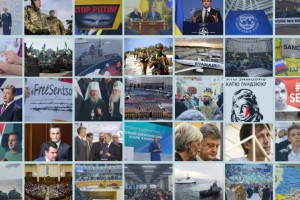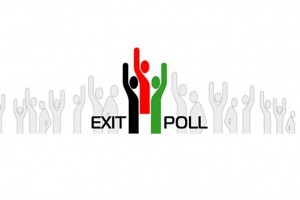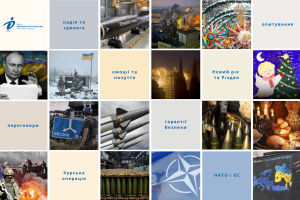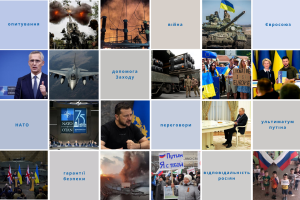The Ilko Kucheriv Democratic Initiatives Foundation conducted a face-to-face poll in cooperation with the Center for Political Sociology from May 7 to 15, 2022 in the seven western (Chernivtsi, Ivano-Frankivsk, Lviv, Rivne, Ternopil, Volyn, and Zakarpattia) and four central (Vinnytsia, Kropyvnytskyi, Khmelnytskyi, Cherkasy) regions of Ukraine. 1,000 respondents were interviewed at the place of their permanent residence. The sample is representative of indicators such as gender, age, type of settlement, and area of residence. The maximum random sampling error amounts to approximately 2.2%.
For comparison, DIF provides data from the surveys conducted in February and December 2021 and February 2022 in the same regions of Ukraine.
The poll was funded by the John Fell Oxford University Press Research Fund.
We use comparison with pre-war statistical data to underline the challenges of conducting public opinion poll during the war and massive forced migration of the people. Our task was to measure and compare changes in the opinion of the people who stayed in their settlements. Migrants/refugees/IDPs were not included. We are aware about the resulting limitations to claims that this poll is representative as our sampling approach was based on pre-war statistical data. A detailed explanation of our polling methodology is presented after the following executive summary.
All conclusions and data of the poll do not reflect opinion of the population of the unsampled central, southern and eastern regions of Ukraine which are most affected by the war. We are, nonetheless, confident that the poll reflects general trends and changes in the Ukrainian society after 90 days of war.
Executive Summary
Compared to the first half of February 2022, support for Ukraine's accession to the European Union increased by 16% among the population of the sampled western and central regions of Ukraine.
Since the beginning of the war, support for NATO membership as the best option to ensure Ukraine’s security increased to 74% (+ 5% comparing to February 2022) in the western and central regions of Ukraine. About 3% of respondents supported Ukraine's non-aligned status (without guarantees) while support for an alternative option, a non-aligned status with strong security guarantees, a new category added in this poll only, is about 13%.
The war has changed public opinion about the strongest allies of Ukraine. According to February 2021 poll, Ukraine's top 3 allies included the United States (38%), Poland (35%) and Germany (28%). In May, 65% of Ukrainians called Poland and 63% mentioned the United States as the strongest allies. Great Britain joined them with an increase of appreciation from 5% in 2021 to 66% in 2022. Favorable opinions of Germany as an ally (-14%), Georgia (-13%) and Belarus (-10%) decreased significantly. Meanwhile, France (+6%) and Turkey (+4) slightly improved their standing. Some countries that are currently providing active military and financial support to Ukraine, like Lithuania or Latvia, have lost some approval. It can be explained by the design of question: respondents were asked to choose no more than three countries. However, even with these limitations, the Baltic countries were ranked similar to larger states like France and Germany.
The beginning of the full-scale invasion of the Russian Federation into the territory of Ukraine has made us change the wording of some questions and answer options. If before the invasion we asked respondents about actors who are responsible for the war in Donbas, in May 2022, we asked about responsibility for the current hostilities. Still, in both cases the role of Russia is evident.
Given these caveats, it is possible to draw a cautious observation that in the last four months more people, who permanently live in the sampled western and central regions of Ukraine, started to think that the leadership of Russia is responsible for beginning of the war. This number increased from 61% in February 2022 to 96% in May 2022.
Moreover, the majority of respondents (54%) say that the Russian people are also responsible for the war. At the same time, the number of people who believe that the main blame lies with the leadership of the United States or the Ukrainian government has significantly decreased.
With the same reservations, we can say that that since the beginning of war, Ukrainians have become more reluctant to give any concessions to the Russian Federation in exchange for its consent to end the military aggression. As of May, 78% were against any concessions to Russia (43% in February 2022). The share of respondents willing to refuse accession to NATO has also dropped to 7% (14% in February 2022). We should, however, bear in mind that in February respondents were asked about concessions for the sake of peace and ending the war in Donbas, which was widely discussed, while in May, people responded to question about concessions to Russia in exchange for stopping the current invasion.
Respectively, most Ukrainians from the western and central regions do not see the possibility for fruitful negotiations with Russia. While 44% of respondents support negotiations with Russia only on humanitarian issues, 34% think that any negotiations with Russia must be completely suspended until Russian troops are forced to retreat beyond the state borders of Ukraine. Only 12% of respondents said that negotiations can go on if Russia demonstrates its ability to make concessions and only 2% believe Ukraine should continue peace talks even if it requires more concessions.
In May 2022, 94% of citizens from the western and central regions believed in Ukraine's victory in the Russian-Ukrainian war. Only 1% had the opposite opinion.
Among the respondents who are confident of Ukraine's victory (78%), 41% see it as expulsion of Russian troops from all of Ukraine and a full restoration of control over the state borders. The same number of respondents (41%) believe that victory is total defeat of the Russian army and assistance to insurgency inside Russia/disintegration of Russia.
We also asked respondents about their attitudes toward Russia and Russian people after the end of war. 91% of respondents are in favor of a complete breakup of all (economic, diplomatic) relations with the Russian Federation, including a total ban on the entry of Russians into Ukraine. 4% of respondents oppose such steps. Another 6% have not yet decided on their position on this issue.
We also tested respondents’ attitudes toward a number of different interpretations of the Ukrainian/Russian relations. According to the poll, 88% of citizens living in the western and central regions of Ukraine agree with the statement that the war is the result of Russia's aggressive foreign policy, while 7% back the statement that the war was caused by Ukraine's desire to join NATO.
Since December 2021, the public support for total ban of the Russian artists and films increased to 71% (+14%) while the share of the population, which considers such prohibition as mistake and violation of rights fell to 8% (-18%). The number of undecided grew to 21% (+4%).
Finally, more people became concerned about a military threat from Belarus. In May 2022, 34% of respondents consider such threat as high (+24% since February), 34% saw it as moderate (+9%) and 17% believed it was low (-19%). 16% of respondents were undecided (-12%).
Explanation of the Sampling Methodology
After the Russian invasion of Ukraine, it has become impossible to conduct representative public opinion polls in a number of regions due to the large-scale evacuation of the population. Therefore, it was decided to do polling only in regions that have undergone relatively minimal changes in terms of security and demographic structure. According to the study "Ukrainians and the War" conducted on April 9-11, 2022 by the research panel "Vlasna Dumka" of Research.ua, most Ukrainians remained in their place of residence in the West (90.9%) and Center (89.7%). At the same time, most IDPs moved from the East (62.6%) and the North (32.8%).[1] Although the population movements in the West and Center are still significant, these regions have remained the most stable across Ukraine.
Then, according to a research plan, a quota sampling of the adult population of the seven western and four central regions of Ukraine (18+) was implemented. It was planned to interview 1,000 respondents who represent the local population of these regions by type of settlement, age, and sex.
At the first stage of the quota, according to the State Register of Voters on February 1, 2022, sampling 1,000 questionnaires were distributed in proportion to the adult population (age 18+) between eleven regions of Ukraine (Table 1).
Table 1
Distribution of general population and sampled population among the regions of Ukraine, % and number
Regions of Ukraine | Number of voters (18+) | Share in the general population (%) | Planned number of respondents |
1. Vinnytsia region | 1216795 | 11,13 | 111 |
2. Volyn region | 767910 | 7,02 | 70 |
3. Zakarpattia region | 942284 | 8,62 | 86 |
4. Ivano-Frankivsl | 1051565 | 9,62 | 96 |
5. Kropyvnytskyi region | 722291 | 6,62 | 66 |
6. Lviv region | 1918756 | 17,55 | 176 |
7. Rivne region | 858153 | 7,84 | 79 |
8. Ternopil region | 810142 | 7,42 | 74 |
9. Khmelnitskyi region | 992418 | 9,08 | 91 |
10. Cherkasy region | 964161 | 8,81 | 88 |
11. Chernivtsi region | 688218 | 6,29 | 63 |
Total | 10932693 | 100 | 1000 |
In the second stage of selection, based on the typology of cities and districts of the each region, cities and districts were selected for the survey. The poll was be conducted in all regional centers in proportion to the number of voters in these settlements. In each region, the questionnaires were distributed among the cities – regional centers, other towns and villages in proportion to the population in these types of settlements, according to the State Statistics Service of Ukraine[2]. One city and 1-2 rural districts were selected from the cities of regional and district subordination in each region.
In the third stage of selection in each of the rural areas, villages were randomly selected for the polling. In the cities, 1–10 streets were selected for the polling. In total, the poll was conducted in 22 cities and 19 villages. For the sample in each selected town and village of each region, quotas were calculated according to the sex and age of the respondents, so that their structure corresponded to the socio-demographic parameters of this region. Thus each city and village, included in the poll, represent not themselves but a certain type of village, town or city.
[2] Statistical publication "Number of Present Population of Ukraine, as of January 1, 2021". Kyiv: State Statistics Service of Ukraine.








